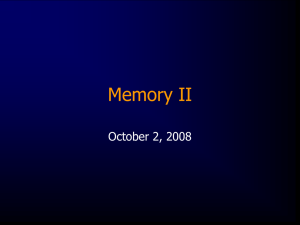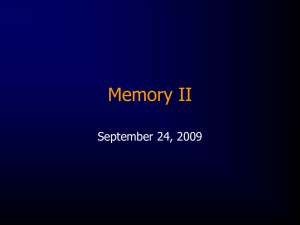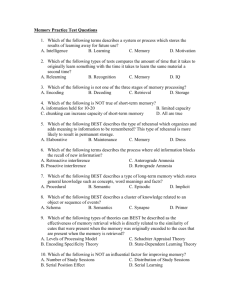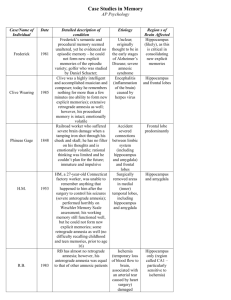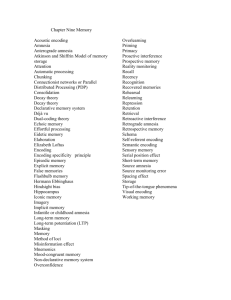Purposes of Attention
advertisement
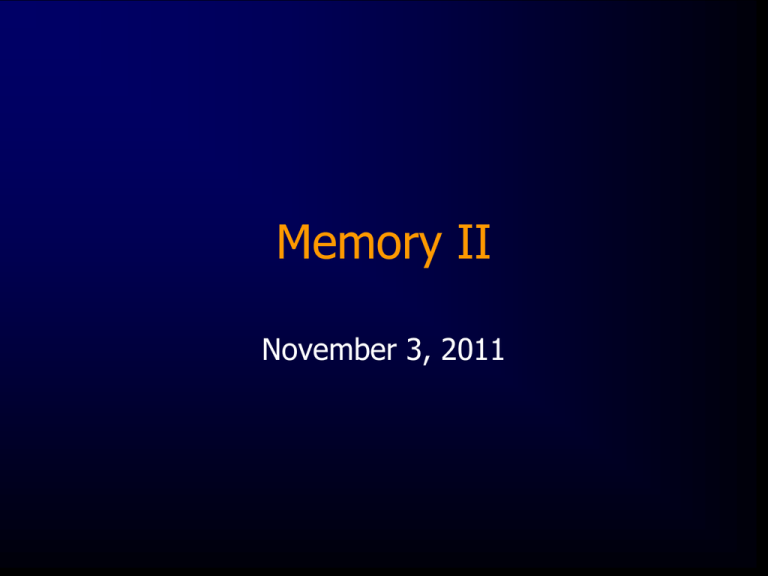
Memory II November 3, 2011 The Case of Henry M (H.M.) Lesion includes: -medial temporal pole cortex -most of the amygdala -entorhinal cortex -more than half of the hippocampus -subiculum -some debate about temporal stem and perirhinal cortex Two Limbic Circuits Anterior Thalamus Mammilary Bodies Cingulate Gyrus Dorsomedial Thalamus Mamillothalamic Tract Fornix Hippocampus Medial (Papez) Orbitofrontal Amygdalofugal pathways Uncus Amygdala Lateral After 60 years: Where lesions produce amnesia Integrated Circuitry Linking Temporal, Diencephalic, and Basal Forebrain Regions The Human Amnesic Syndrome • Impaired new learning (anterograde amnesia), exacerbated by increasing retention delay • Impaired recollection of events learned prior to onset of amnesia (retrograde amnesia, remote memory impairment), often in temporally graded fashion • Not limited to one sensory modality or type of material • Normal IQ, attention span, “nondeclarative” forms of memory Anterograde/Retrograde Distinction • Typically see both AA and RA in amnesia (“no RA without AA”) – but there are exceptions • Three patterns of RA in “classic” amnesia – Temporally-graded – Temporally-limited – Decade-nonspecific • Selective (focal) retrograde amnesia Patterns of Retrograde Amnesia Normals Normals Amnesics Amnesics Normals Amnesics Remote Recent Temporally-Graded RA Seen in AK Remote Recent Temporally-Limited RA Seen in MTL Remote Recent Decade-Nonspecific RA Seen in Basal Ganglia (HD) disease Frontal/Executive Contributions to Memory – Temporal ordering (“time tagging”) of memories • Contextual aspects of memory – Source memory (memory for where information was learned) – Metamemory (“feeling of knowing”) – Prospective memory (“remembering to remember”) Theoretical Accounts of Amnesia 1. Encoding deficit • • • • Amnesics have difficulty organizing and learning TBR information for later recall Evidence from LOP studies Can explain: AA (impairment in new learning, or recent memory) Has difficulty explaining: shrinking RA RA at 2 weeks RA at 6 months trauma Theoretical Accounts (cont.) 2. Consolidation deficit • • • • “post-encoding” deficit: difficulty in the consolidation of TBR information Huppert & Percy (1979): accelerated rates of forgetting Can explain: rapid forgetting in amnesia; shrinking RA Can’t explain: extensive (long term) RA Theoretical Accounts (cont.) 3. Retrieval deficit • • • • • Studies showing amnesics are abnormally susceptible to interference Retrieval is often aided by cuing Inconsistent performance across testing situations Indirect versus direct tests of memory Helpful in explaining some retrograde deficits Spared Abilities in Amnesic Disorders 1. Attention span (e.g. digit span) 2. Measured intelligence 3. Nondeclarative/implicit forms of memory • • • • Skills; skill learning (rotary pursuit, mirror tracing or reading) Priming (perceptual and conceptual) Conditioning ‘familiarity’ Perceptual Priming Word-Stem Completion Study: HOLIDAY, TABLE, PRODUCE, GARAGE, ANTENNA, CHILDREN Test: “This is a word puzzle. Complete each stem with the first word that comes to mind.” Effect: Each stem could make at least 10 English words, so baseline probability of completing in target direction < .10. Exposure produces a 30% increment in this probability, even when the word is not recognized as a target. • IMM_______ • PAR_______ • GRA_______ • HOL_______ • PRO_______ • CHI_______ Word-Fragment Completion • AL__GA_O_ • T_B_ O G _ N • E_E_A_O_ • G_R___F_ • Each word has a unique completer • Measure RT or accuracy-withdeadline Explicit and Implicit Memory • Explicit memory – Conscious recall of to-be-remembered (TBR) information – Supposedly measured through DIRECT tasks • Implicit memory – Unconscious or unintentional recollection of previously-presented material – Supposedly measured through INDIRECT tasks Explicit-implicit dissociations: Systems vs. Process Debate • Systems: IM and EM represent two separate memory systems (functionally and anatomically) • Process: IM & EM differ in terms of the underlying processes involved in task performance – Conceptual versus perceptual processing The “Systems” View: Characteristics of a Memory System Distinction based on cognitive operations • Deliberate (recollection) v. Nondeliberate (familiarity) retrieval mode • Remember v. know Distinction based on content and neural substrates • Core memory system (episodic memory) v. cortex (priming) • Core memory system (episodic memory) v. striatum (skills) Convergent (double) dissociations (functional, anatomical) • Stochastic independence of recalled and primed items The “Process” view • Direct and indirect tests tap different processes within the same memory system • Crux of the argument: processes at “study” match those at “test” for successful performance (ESP, or more broadly “transfer-appropriate processing”) • Data-driven: indirect tasks (implicit) – Perceptually based – Modality dependent • Conceptually-driven: direct tasks (explicit) – Conceptually based – Modality independent Process-Based Explanations of Amnesia • Systems: Amnesia disrupts the system responsible for explicit, not implicit memory • Process: Amnesia represents an impairment in conceptual processing, regardless of the test type – Perceptual processing is intact on both direct and indirect tests Characteristics of Conceptual and Perceptual tests Perceptual • Modality-dependent (changes in modality between study and test adversely affect performance) • Meaning-independent • Based on physical or sensory characteristics • Not tapped by typical clinical memory tests • Modalityindependent • Meaning-dependent (changes in meaning between study and test adversely Conceptual affect performance) • Based on semantic characteristics • Most clinical memory tests tap this Memory System Declarative Data-Driven Stem completion, perceptual identification (perceptual) Conceptually -Driven (conceptual) (from Roediger, 1990) Nondeclarative Free recall, cued recall, recognition Memory System Data-Driven (perceptual) Conceptually -Driven (conceptual) (from Roediger, 1990) Declarative Nondeclarative Graphemic cued recall Stem completion, perceptual identification Free recall, cued recall, recognition Category exemplar generation, general knowledge test Blaxton, 1985 (Exp. 2) Modality effect in data-driven, but not conceptuallydriven tasks Generate: at learning were given tin – C _ _ _ _ _ and generated “copper” No Context: at learning, were given XXX-COPPER SS Aud Vis BRAIN DIAGRAM ModalityNonspecific Representations (conceptual) Modality-Specific Representations (perceptual) Synthesis • Current data is favorable for both system and process views • Multiple forms of memory are represented by a distributed memory system • Fractionated memory impairments possible with subtotal damage to memory system Two-Process Theory (Mandler, Jacoby) • Recollection: a ‘controlled’ process in which there is conscious retrieval of a prior learning episode • Familiarity: an ‘automatic’ process in which the results of prior exposure or processing lead to a feeling of familiarity or ‘perceptual fluency’ EXAMPLE: CHI________ Process Dissociation Procedure • Manipulate task instructions to separately evaluate recollection (R) and familiarity (F) • Inclusion vs. exclusion test – Inclusion: R + F both work to produce memory – Exclusion: R and F lead to opposite effects – Example: In WSC: “Complete the stem with the first word that comes to mind (inclusion), but if that word is a target, choose another word” (exclusion). • Derive formulae to calculate recollection and familiarity from performance data • Many manipulations (e.g., age, dividing attention) affect R but not F A B C Problems with Process-Dissociation • Assumes independence of recollection and familiarity; however R and F are often correlated • Seriousness of this problem depends upon mode of retrieval/instructions – Generate-recognize (first word that comes to mind): R & F not independent – Direct retrieval (use cue for retrieval): Assumption of independence more tenable Recollection v. Familiarity Recollection and Familiarity in the Brain Diana, Yonelinas, and Ranganath, TICS, 2007) Figure 3. Anatomy of the MTL region. (a) Approximate locations of the hippocampus ( Recollection v. Familiarity • Figure 1. Activation of MTL subregions in studies of recollection and/or familiarity. Shown is the percentage of contrasts of each type (recollection, familiarity or associative recognition) in which activation was reported for the hippocampus, the posterior parahippocampal gyrus (PPHG) and the anterior parahippocampal gyrus (APHG). Data are summarized from Tables 1 and 2. Diana, Diana, Yonelinas, & Rangrath, 2007, Trends in Cog Sci Remember-Know • Two subjective states of remembering • Seem to be relatively independent • Many variables affect remembering but not knowing • ERP’s distinguish R vs. K words irrespective of study history • Lorazepam reduces remembering and leaves knowing intact Functional Neuroimaging of Memory • Allows evaluation of “in vivo” memory performance • Allows evaluation of extended networks of memory • Some techniques allow real-time assessment (event-related BOLD fMRI) Functional Imaging of Explicit Memory • HERA (hemispheric encoding-retrieval asymmetry) model – Encoding preferentially associated with LDLPFC activation – Retrieval preferentially associated with RDLPFC activation But there’s also materialspecificity Activations (hot) and Deactivations (cool) and successful encoding Sperling, et al., 2009 Hemispheric Asymmetry Reduction in Old Age (HAROLD) Explanations: -compensation -dedifferentiation Functional Imaging of Explicit Memory 2 • Prefrontal, MTL responses greater during learning if items eventually remembered • Hemispheric asymmetries in material (verbal vs. nonverbal) • TP differentiated from FP • Hippocampus active during encoding, less so during retrieval Functional Imaging of Perceptual Priming Multiple Trace Theory • Previous studies suggest hippocampus important in laying down a new memory but becomes less important over time • MTT suggests, in contrast to standard model, that hippocampus is always involved in retrieval of autobiographical memories, however old Cabeza & St. Jacques, 2007 Dissociations of forms of memory • Selective impairment in STM with preserved LTM • Impairment in semantic memory with relatively preserved episodic memory (e.g., semantic dementia) • Selective retrograde amnesia • Selective impairments in skill learning and priming Metamemory • • • • Thinking about thinking Allows control of retrieval RJR (recall-judge-recognize)/FOK paradigm Theories (all explain some data) – Target retrievability hypothesis – judgment based on knowing the answer, or part of it – Cue familiarity hypothesis – judgment based on familiarity with the cue • e.g. CHARM (monitoring/control prior to retrieval) – Accessibility heuristic (e.g. speed of access) Metamemory: Sample findings • Tip-of-the-tongue phenomenon – Can recall phonemic information, number of syllables, gender of speaker, etc. Strongest evidence for accessibility hypothesis • Retrieval Latency – Game show paradigm: give answer or say “know it” as fast as possible (“fast fingers”). Responses faster in FOK than in retrieval. Favor cue-familiarity hypothesis. • Knowing not – Judgments about what is not known are made accurately and very quickly. Appears to be positively marked and immediately accessible. • Dissociation between FOK and recognition – Seen in some forms of amnesia (e.g., Korsakoff patients) but not in others. May be attributable to frontal lobe impairment in self-monitoring Reconstructive Memory • Reconstructive vs. reproductive • Paradigms – Post-event manipulations – Minsinformation acceptance • Associated phenomena – “Own” bias – motivated self-enhancement – “Hindsight” bias • Clinical implications: self report
